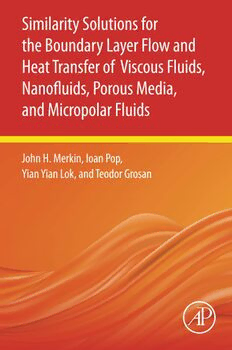
Similarity Solutions for the Boundary Layer Flow and Heat Transfer of Viscous Fluids, Nanofluids, Porous Media, and Micropolar Fluids PDF
Preview Similarity Solutions for the Boundary Layer Flow and Heat Transfer of Viscous Fluids, Nanofluids, Porous Media, and Micropolar Fluids
SIMILARITY SOLUTIONS FOR THE BOUNDARY LAYER FLOW AND HEAT TRANSFER OF VISCOUS FLUIDS, NANOFLUIDS, POROUS MEDIA, AND MICROPOLAR FLUIDS This page intentionally left blank SIMILARITY SOLUTIONS FOR THE BOUNDARY LAYER FLOW AND HEAT TRANSFER OF VISCOUS FLUIDS, NANOFLUIDS, POROUS MEDIA, AND MICROPOLAR FLUIDS JOHN H. MERKIN Department of Applied Mathematics, University of Leeds, Leeds, United Kingdom IOAN POP Department of Mathematics, Faculty of Mathematics and Computer Science, Babeş-Bolyai University, Cluj-Napoca, Romania YIAN YIAN LOK MathematicsSection,SchoolofDistanceEducation,UniversitiSains Malaysia, Pulau Pinang, Malaysia TEODOR GROSAN Department of Mathematics, Faculty of Mathematics and Computer Science, Babeş-Bolyai University, Cluj-Napoca, Romania AcademicPress isanimprintofElsevier 125London Wall,London EC2Y5AS,UnitedKingdom 525BStreet,Suite1650,SanDiego,CA92101,UnitedStates 50HampshireStreet,5thFloor, Cambridge,MA02139,UnitedStates TheBoulevard,Langford Lane,Kidlington,OxfordOX5 1GB,UnitedKingdom Copyright©2022ElsevierInc.Allrightsreserved. Nopartofthispublicationmaybereproducedortransmittedinanyformorbyany means,electronicormechanical,includingphotocopying,recording,oranyinformation storageandretrievalsystem,withoutpermissioninwritingfromthepublisher.Details on how to seek permission, furtherinformation about the Publisher’s permissions policiesand ourarrangementswith organizationssuch as the Copyright Clearance Centerand the Copyright Licensing Agency, can befound at ourwebsite: www.elsevier.com/permissions. Thisbookandtheindividual contributionscontainedinitareprotected under copyrightbythePublisher (otherthanasmaybenotedherein). Notices Knowledgeandbestpracticeinthisfieldareconstantlychanging. Asnew research andexperiencebroadenourunderstanding, changesinresearch methods,professional practices,ormedical treatment maybecomenecessary. Practitionersandresearchersmustalwaysrelyontheir ownexperience andknowledge inevaluating andusingany information,methods,compounds,orexperiments describedherein. Inusingsuchinformation ormethods theyshouldbemindfulof theirown safetyandthesafetyofothers,includingpartiesforwhomthey havea professionalresponsibility. Tothefullestextentofthelaw,neither thePublishernortheauthors,contributors, or editors,assume anyliabilityforanyinjury and/ordamagetopersonsorproperty asa matterofproductsliability,negligence orotherwise,or fromanyuseor operationof anymethods,products, instructions,or ideascontainedinthematerialherein. LibraryofCongressCataloging-in-Publication Data Acatalogrecord forthisbookis availablefromtheLibrary ofCongress BritishLibraryCataloguing-in-Publication Data Acataloguerecord forthisbook isavailablefromtheBritishLibrary ISBN:978-0-12-821188-5 Forinformation onallAcademic Presspublications visitourwebsite at https://www.elsevier.com/books-and-journals Publisher:Matthew Deans Acquisitions Editor: BrianGuerin EditorialProjectManager:HilaryCarr ProductionProjectManager:Sojan P.Pazhayattil Coverdesigner: VictoriaPearson TypesetbyTNQTechnologies Contents Preface ix 1. Basic equations and mathematical methods 1 1.1 Basicequations 1 1.2 Similarity solutions 9 1.3 Somenumerical methods 11 1.4 Analyticalsolutionmethods 15 Nomenclature 17 Greekletters 18 Subscript 18 References 18 2. Viscous fluids 23 2.1 Unsteadymixedconvectionflowatathree-dimensional stagnation point 23 2.2 Mixedconvectionboundarylayerflownearthestagnation pointon avertical surfacewithslip 34 2.3 MixedconvectionnonaxisymmetricHomannstagnation-point flow 41 Nomenclature 46 Greekletters 47 Subscript 47 Superscript 47 References 47 3. Stretching/shrinking sheets near a stagnation-point flow in viscous fluids 49 3.1 Introduction 49 3.2 Unsteadyseparatedstagnation-point flowtowardstretching/shrinking sheet 49 3.3 Axisymmetric rotationalstagnation-point flowoverapermeable stretching/shrinking rotatingdisk 55 3.4 Magnetohydrodynamic obliquestagnation-point flowtowarda stretching/shrinking surface 73 Nomenclature 83 Romanletters 83 v vi Contents Greeksymbols 83 Subscripts 84 References 84 4. Nanofluids 87 4.1 Forcedconvectionboundarylayerflowpastnonisothermal thin needlesinnanofluids 87 4.2 Axisymmetric mixedconvectionboundarylayerflowpastavertical cylinderinananofluid 92 4.3 Blasius andSakiadis problemsinnanofluids 105 Nomenclature 110 Greekletters 111 Subscript 111 Superscript 111 References 111 5. Stretching/shrinking sheets in nanofluids and hybrid nanofluids 113 5.1 Flowandheattransferoveranunsteadyshrinking sheetwith suctioninananofluidusingBuongiorno’smodel 113 5.2 Axisymmetric rotationalstagnation-point flowimpingingradially a permeablestretching/shrinking surfaceinananofluid 119 5.3 Flowandheattransferoverapermeablebiaxialstretching/shrinking sheetinananofluid 127 5.4 Numericalsolutions ofnonalignment stagnation-point flowandheat transfer ofananofluidoverastretching/shrinkingsurface inananofluid 134 5.5 Flowandheattransferalongapermeablestretching/shrinking curved surfaceinahybridnanofluid 140 5.6 MHDflowandheattransfer overapermeable stretching/shrinking sheetinahybridnanofluidwithaconvective boundarycondition 151 Nomenclature 157 Greekletters 158 Subscript 158 Superscript 159 References 159 6. Mixed convection flow in porous medium 163 6.1 Introduction 163 6.2 Mixedconvectionboundarylayerflowonaverticalsurface ina saturatedporousmedium 164 6.3 Steadymixedconvectionflowoverapermeablevertical thin cylinderinaporousmedium 167 Contents vii 6.4 Mixedconvectionboundarylayerflowfromaverticalflatplate embedded inaporousmediumfilledwithnanofluids 172 6.5 Mixedconvectionboundarylayerflowalongavertical cylinder embedded inaporousmediumfilledbyananofluid 178 6.6 Mixedconvectionboundarylayerflowoveraverticalplate embedded inaporousmediumfilledwithasuspensionof nano-encapsulated phasechangematerials 186 Nomenclature 195 Greekletters 196 Subscript 196 Superscript 197 References 197 7. Convective flows with internal heat generation in porous media 205 7.1 Introduction 205 7.2 Flowswithtemperaturedependent heatgeneration 205 7.3 Flowswithspatiallydependentheatgeneration 217 7.4 Concludingremarks 220 Nomenclature 221 Greeksymbols 221 References 221 8. Micropolar fluids over the moving surface 225 8.1 Introduction 225 8.2 Mixedconvectionflowofamicropolar fluidnearastagnation-point flowoverastretchingsurface 227 8.3 Obliquestagnationeslip flowofamicropolarfluidtowarda stretching/shrinking surface 231 8.4 Moving wedgeandflatplateinamicropolarfluid 241 Nomenclature 248 Greeksymbols 248 Subscripts 249 References 249 9. Jets 255 9.1 Introduction 255 9.2 Wall jet 258 9.3 JetprofilesolutionsoftheFalknereSkanequation 263 9.4 Numerical modelingofGlauerttypeexponentially decaying wall jetflowsofnanofluidsusingTiwariandDas’nanofluidmodel 266 viii Contents Nomenclature 273 Greekletters 274 Subscripts 274 Superscripts 274 References 274 Index 277 Preface Fluid mechanics is a major part of applied mathematics, of physics, and in many branches of engineering,particularly civil, mechanical, chemical, and aeronautical engineering. It also plays an important role in naval architec- ture,geophysics,aswellasinastrophysics,biologicalandphysiologicalfluid dynamics. Significant contributions to the theory of airfoils came early in the 20th century, and during the whole of the first-half of this century applied aerodynamics was the major incentive, but also dealing with questions that were important in both mechanical and civil engineering. Partial differential equations are the basis for nearly all technical pro- cesses in heat transfer and fluid mechanics. In our research activity, we became aware of the fact that a lot of researchers focus increasingly on numerical methods for solving the partial differential equations involved in their problems. Analytical methods, taught in fluid mechanics and heat transfer courses, are often quickly discarded, because of the common belief that almost all problems appearing in real applications can be solved easily bynumericalmethods.Thebasicideaofthisbookistoshowsomeselected analytical and numerical methods and to explain their application to more complicated problems, which are technically relevant. Of course, this means that some of the standard analytical methods might not be discussed andpresentinthisbook(forexample,integraltransforms,Liegroups,etc.). Ontheotherhand,theanalyticalmethodsdiscussedhereareapplicabletoa range of interesting problems and to applied mathematicians. Also, PhD students or engineers could learn how to solve useful technical problems analytically. There is no doubt that the knowledge of numerical solution methods is very important, and there is an opportunity in using both nu- merical and analytic tools to gain useful insights into flow physics and heat transfer characteristics. However, numerical methods are always dependent on grid quality and grid size and on a lot of implementation features. Perhaps the most important development in fluid mechanics during the 20thcenturywastheconceptofboundarylayerflowintroducedbyPrandtl in 1904. A boundary layer is a layer of fluid which forms on a surface bounding the moving fluid. Every time a fluid moves along a surface a boundarylayerformsonthesurface.Therefore,boundarylayersexistinthe interiorofwaterpipes,insewerpipes,inirrigationchannels,neartheearth’s surface, and around buildings due to winds, near aeroplane wings, around a ix
